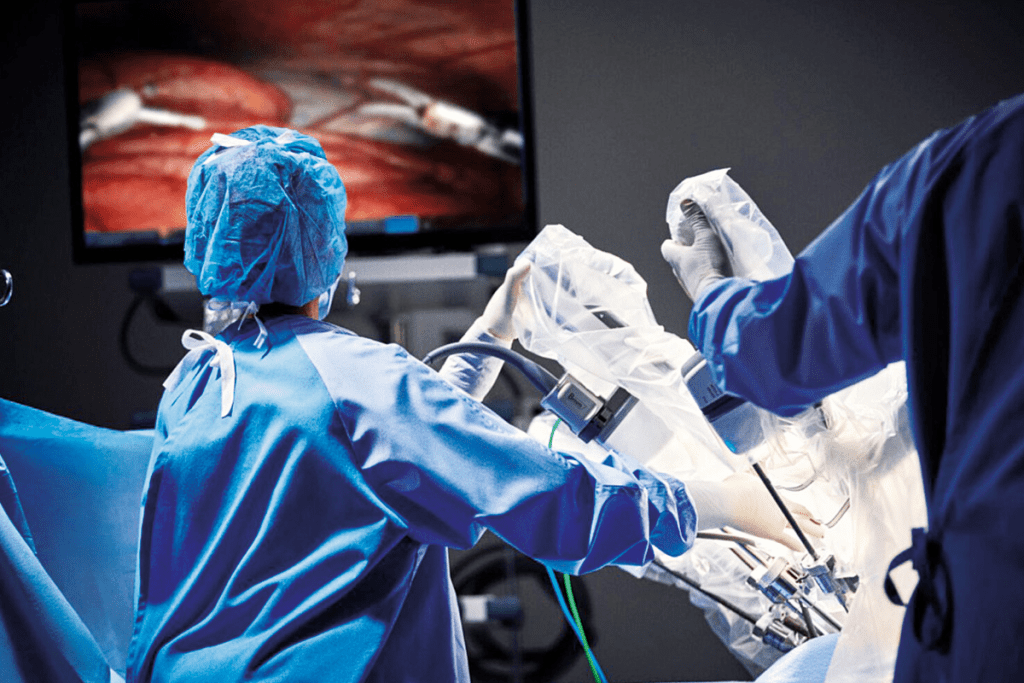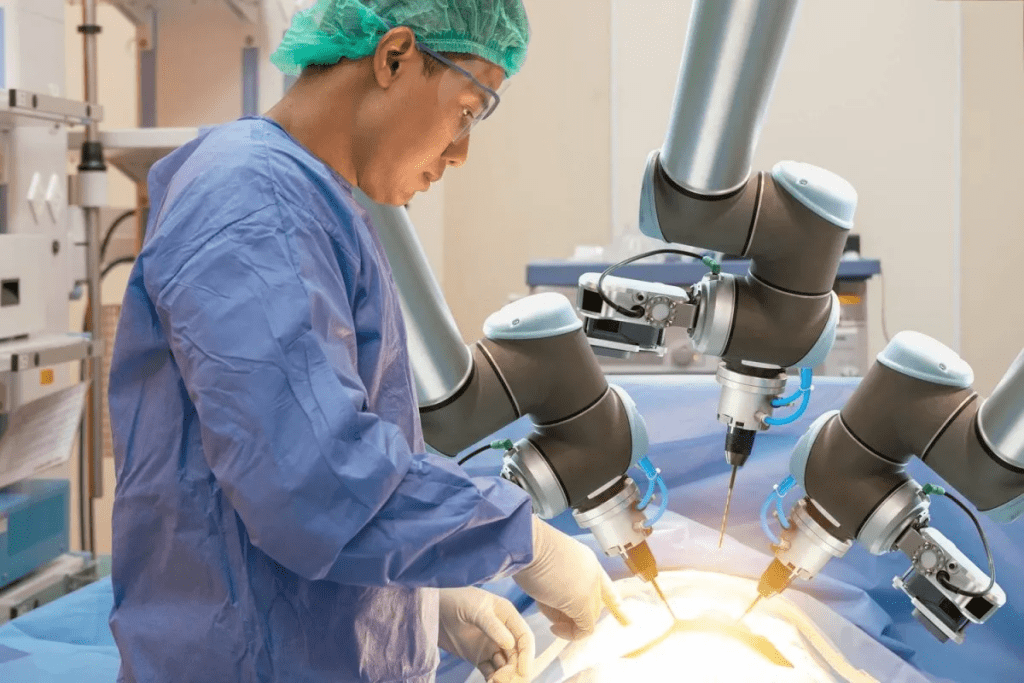Last Updated on October 31, 2025 by

As surgery evolves worldwide, minimally invasive procedures are becoming more common. They offer patients quicker recovery times and fewer side effects. But, are these modern methods truly surgeries?
Many ask if a minimally invasive procedure is a type of surgery. Doctors say, “Robotics is the peak of minimally invasive surgery.” These procedures use small or no cuts, with tools like laparoscopes or endoscopes. They differ from old-school open surgeries, bringing many benefits to patients.
At Liv Hospital, we share this vision. We aim to compete globally and use the latest, evidence-based care. Our goal is to keep improving in quality, offer diverse services, and enhance patient experience.
Medical technology keeps getting better, leading to more options for surgery. Minimally invasive surgery (MIS) is a method that cuts less through the skin and tissues. This means less pain for patients, shorter hospital stays, and faster recovery times.
Minimally invasive surgery uses small cuts and special tools like laparoscopes or endoscopes. These tools help surgeons work with great precision. MIS includes laparoscopic surgery, endoscopic procedures, and robot-assisted surgery.
Laparoscopy is a big part of MIS. It uses a thin, lighted tube with a camera to see inside the body. This method is used for many surgeries, like removing the gallbladder and fixing hernias.

The history of MIS is filled with big steps forward. Laparoscopic surgery, for example, has changed how many surgeries are done. It started with simple procedures, but now handles more complex ones.
There have been many important moments in surgery’s history. Some key ones include:
These changes have made MIS safer and more effective. We keep working to give our patients the best care possible.
Minimally invasive surgery is different from traditional surgery. It uses advanced techniques to cause less damage and help patients recover faster. This is mainly because of smaller incisions and the use of special tools and technology.
Traditional surgery needs big cuts to let surgeons see and work on the body. Minimally invasive surgery, on the other hand, uses small cuts, about 0.5 to 1.5 cm. These small cuts cause less damage and pain to the patient.
Research shows that MIS cuts are less painful and have a lower risk of infection. For example, robotic heart surgery patients have less pain, less bleeding, and fewer infections than those with traditional open-heart surgery.
The success of MIS depends a lot on specialized tools and technology. This includes high-definition cameras and robotic systems. These tools help surgeons do complex tasks with more precision and control.
Robotic systems, for instance, offer enhanced visualization and dexterity. This means surgeons can do more detailed work. Dr. says, “Robotic heart surgery… results in less pain, less bleeding, and less infection.”

At our institution, we use the latest in MIS to give our patients the best care. We combine skilled surgeons with cutting-edge technology. This way, we focus on making our patients comfortable and helping them recover quickly.
By 2023, over 80% of surgeries will be minimally invasive. This shows how important these methods are. They offer effective treatments with fewer side effects and quicker healing.
We use different MIS techniques for various conditions. This ensures our patients get the best and least invasive care.
Laparoscopic surgeries are very common. They involve small incisions for a laparoscope and tools. The laparoscope shows images on a monitor, helping surgeons like removing gallbladders laparoscopically.
This method causes less damage and helps patients heal faster.
Endoscopic procedures are also key in MIS. They use an endoscope through natural openings or small cuts. The endoscope has a camera and light, letting surgeons see inside the body.
For example, sinus surgery is often done this way. It’s less painful and quicker to recover than the old methods.
The medical world keeps growing, with new non-invasive and less invasive options. Robotic-assisted surgery and laser treatments are becoming more common. These give patients more choices for their care.
We keep up with new tech and techniques. This way, we can offer our patients the best care with little disruption to their lives.
In conclusion, today’s minimally invasive surgeries let us tailor treatments for each patient. By using the latest technology and methods, we ensure top-quality care with minimal impact on patients’ lives.
Modern minimally invasive surgery has changed the medical world. It offers many benefits to patients all over the globe. This method is designed to reduce the harm of traditional surgery, cutting down recovery times and improving results.
This field keeps advancing, showing that minimally invasive procedures are setting a new standard in care. Research shows these procedures can cut hospital stays by a lot. Patients often go home in a day or two, unlike traditional surgery, which keeps them in the hospital longer.
One big advantage is the shorter hospital stay, often by 70%. This is because of the smaller cuts and less damage to tissue. This leads to faster healing.
Patients usually feel 30-50% less pain after these surgeries. This is because of the smaller cuts and avoiding big open wounds. Traditional surgery often causes more pain.
The approach also lowers infection risk by over 50%. By keeping internal tissues away from the outside, the chance of infection drops. This leads to better health outcomes for patients.
Patients love the faster recovery and getting back to daily life sooner. Minimally invasive surgery helps patients regain strength and get back to normal faster than traditional surgery.
A leading medical source says, “Minimally invasive surgery should have less trauma, complications, and side effects than open surgery.” This highlights the benefits of choosing minimally invasive surgery when it’s an option. At our institution, we aim to give top-notch care. We use the latest in non-invasive medical treatment and surgery to ensure the best results for our patients. Choosing minimally invasive surgery means a safer, more efficient, and less painful surgery for patients.
Choosing to have a laparoscopic or minimally invasive procedure is a big step. It’s important to know what to expect. At our place, we make sure you’re well-informed and comfortable from start to finish.
We check if you’re right for laparoscopic surgery before it starts. We look at your health history, do tests, and talk about your meds. Our aim is to lower risks and improve results. We also give you clear instructions on how to get ready, like what to eat and how to live your life.
We follow strict rules to make sure you’re well-prepared. “Each procedure must be proven safe and effective with randomized trials,” our guidelines say. This means you get the best care based on the latest science.
During your surgery, our expert surgeons use the newest tech and methods. They make small cuts and use special tools for precise work. This approach means less damage and a quicker recovery. Our team works together to take care of you in every way.
Recovering after surgery is usually quicker and less painful than old-school methods. We help you through every step of getting better. Our goal is to get you back to your life fast, but safely.
We focus on more than just the surgery’s success. We want to make sure you feel cared for and supported every step of the way.
Minimally invasive procedures, like laparoscopic surgery, have changed surgery a lot. They offer many benefits to patients. We’ve seen how different surgeries work and how they’re getting more use.
Joseph Dearani, M.D., says these new methods are just as good as the old ones. This shows how effective they can be.
At Liv Hospital, we’re all about these new ways of surgery. We aim to be the best in the world. We make sure our care is top-notch and help patients from all over.
Choosing these new surgeries means less pain and a faster recovery. You can get back to your life sooner. We keep up with the latest in surgery to help our patients get the best care.
A minimally invasive procedure is a surgery that uses small or no cuts. It uses tools like laparoscopes or endoscopes to do operations.
Yes, laparoscopic surgery is a type of minimally invasive surgery. It uses a laparoscope to do operations through small cuts.
Minimally invasive surgery is different from traditional surgery in a few ways. It uses small or no cuts, which reduces tissue damage. This leads to faster healing.
The benefits of minimally invasive surgery are many. It reduces hospital stay, lowers postoperative pain, and cuts down on infections. Recovery times are also faster.
Pre-surgical preparation is thorough. It includes an assessment and planning to ensure the best results. Patients get guided through every step for complete care and support.
Recovery times vary. But patients usually recover faster. They can get back to their daily activities sooner. They often experience less postoperative pain and discomfort.
Yes, there are many types of minimally invasive surgical procedures. These include laparoscopic surgeries, endoscopic procedures, and non-invasive and less invasive interventions.
Specialized tools and technology, like robotic systems, are key in minimally invasive procedures. They help surgeons perform complex operations with more precision.
Subscribe to our e-newsletter to stay informed about the latest innovations in the world of health and exclusive offers!